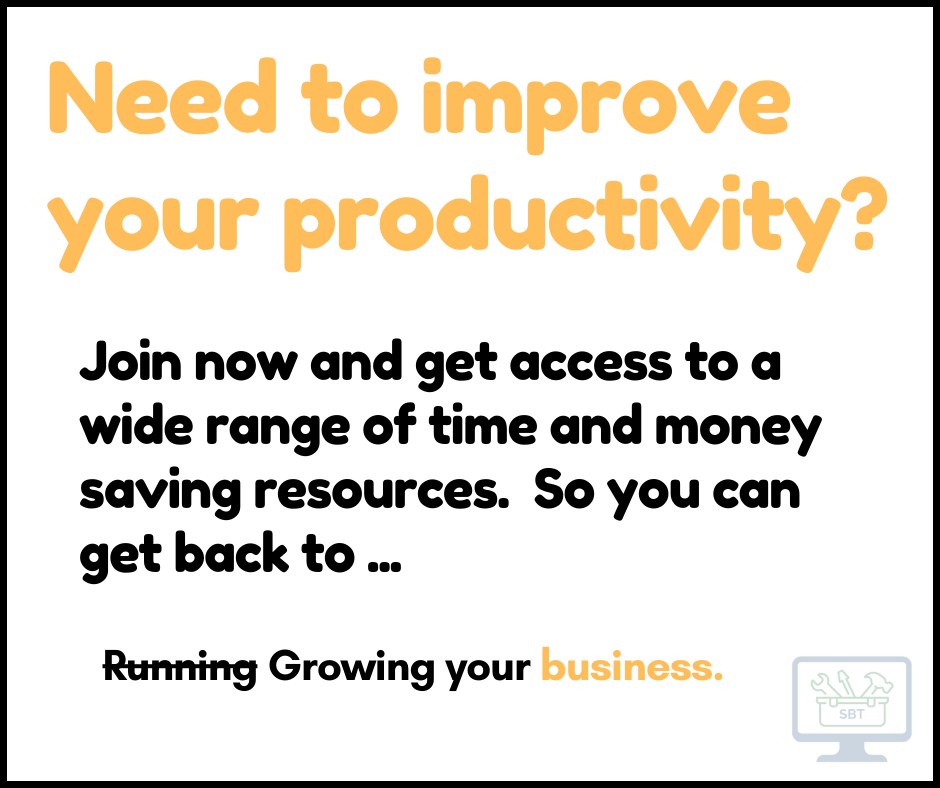In today’s digital age, a small business website is no longer a luxury-it’s a necessity. At SmallBizToolbox, we’ve seen countless entrepreneurs transform their businesses by establishing a strong online presence.
Pros and Cons of Having a Website
| Pros | Cons |
|---|---|
| Increases visibility | Initial setup costs |
| Provides credibility | Requires ongoing maintenance |
| Facilitates customer engagement | Time-consuming to manage |
| Offers valuable analytics | Need for technical knowledge |
| Supports SEO efforts | Competitive landscape |
A well-designed website can boost your credibility, expand your reach, and serve as a powerful marketing tool. But how do you create one, and what elements should it include?

Why Your Business Needs a Website
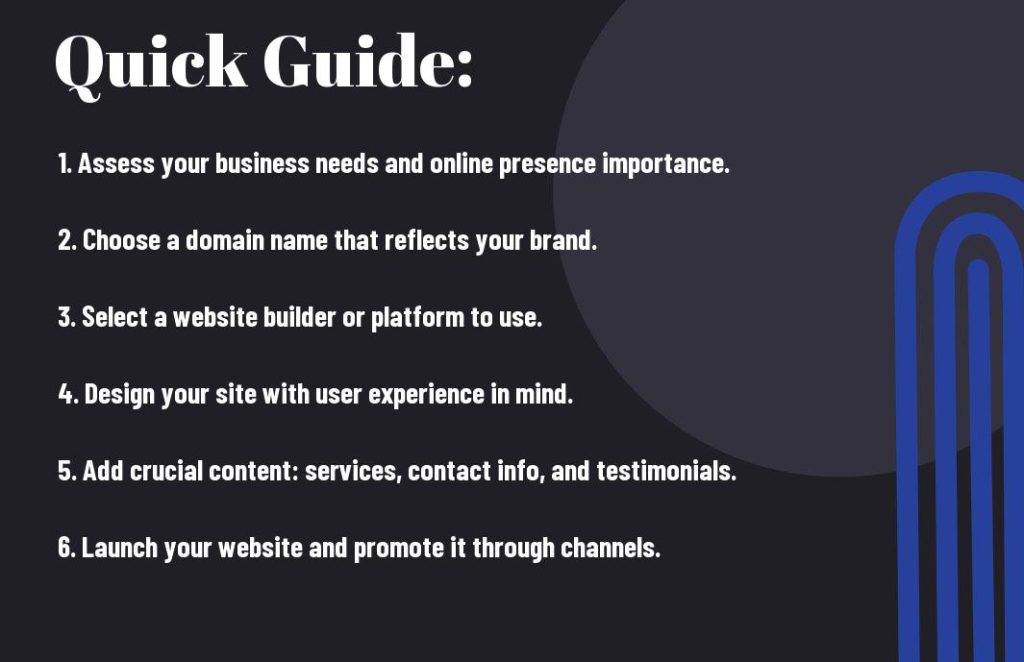
Your Digital Business Card
A website acts as your professional digital business card. It often serves as the first point of contact between you and potential customers. Australian businesses face increasingly sophisticated and capable cybercriminals targeting what matters most to them; their money, data and reputation. This digital presence immediately enhances your credibility and professionalism, distinguishing you from competitors who haven’t yet embraced the online world.
Expanding Your Market Reach
While your physical store might limit you to local customers, your website can reach a global audience. The Australian Bureau of Statistics reported that in 2022, 86% of Australian households had internet access. This statistic translates to potential access to millions of customers across the country and beyond. Search engine optimization of your site can attract customers who actively seek your products or services, regardless of their location.
Always Open for Business
Unlike a physical store with set hours, your website operates 24/7. It provides constant accessibility to your business information, products, and services. A HubSpot study found that 64% of small businesses with websites receive new customer inquiries through their sites outside of business hours. This round-the-clock availability can significantly increase your sales opportunities and customer satisfaction.
Cost-Effective Marketing
Traditional advertising often proves expensive, especially for small businesses. A website, however, offers a more cost-effective alternative. Once established, it continues to market your business with minimal ongoing costs. Content marketing costs 62% less than outbound marketing and generates more than three times as many leads. Regular updates to your website with valuable content can attract and engage customers without the recurring costs of print or broadcast advertising.
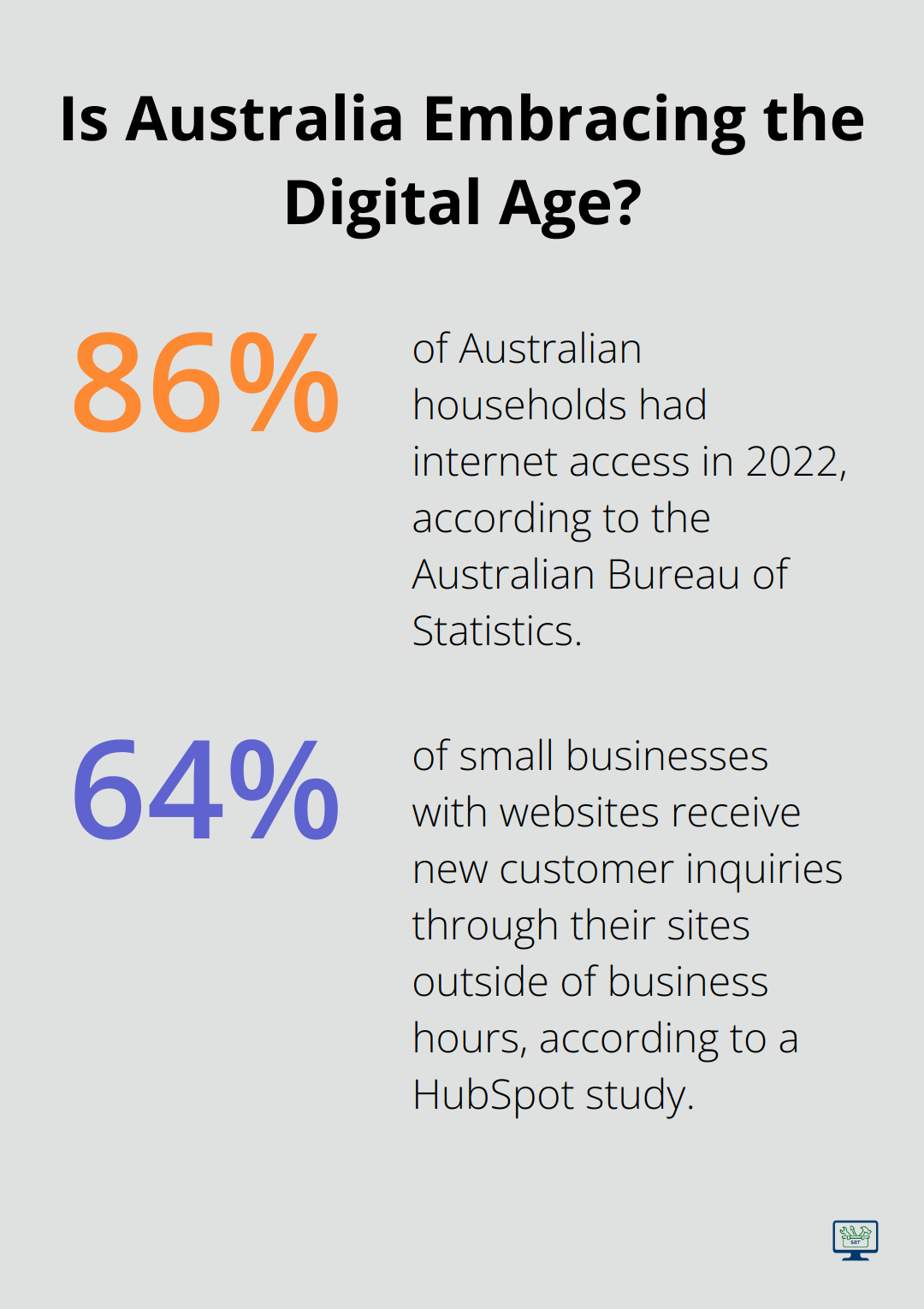
A well-crafted website can transform a small business. It’s not just about having an online presence; it’s about creating a powerful digital asset that works tirelessly to build your brand, attract customers, and grow your business. Whether you’re just starting out or looking to expand, a business website represents an investment that pays dividends in credibility, reach, and growth opportunities. Now that we’ve established the importance of a website, let’s explore the key elements that make a business website successful.
Types of Business Websites
While considering your online presence, it’s vital to choose a business website type that aligns with your goals. Different types of websites cater to various business needs:
- Informational Websites
- E-commerce Websites
- Portfolio Websites
- Blog or Content Websites
- Landing Pages
Any of these options can enhance your business visibility and engagement.
| Website Type | Description |
| Informational Websites | Provide general information about your business and services. |
| E-commerce Websites | Enable online sales of products or services. |
| Portfolio Websites | Showcase your work or projects in a visually appealing format. |
| Blog or Content Websites | Share insights, articles, or news relevant to your industry. |
| Landing Pages | Focus on a specific campaign or product to capture leads. |
Informational Websites
The primary goal of an informational website is to provide visitors with relevant details about your business, including services, contact information, and company background. These sites are ideal for establishing an online presence and building credibility without the complexities of e-commerce functionality.
E-commerce Websites
Websites designed for e-commerce allow you to sell products or services directly to customers over the internet. These platforms typically include shopping carts, payment gateways, and secure checkout processes, making it easy for customers to make purchases.
Plus, e-commerce websites often come equipped with various features like inventory management, customer reviews, and promotional tools, enabling you to enhance customer experience and boost sales. Investing in an e-commerce site can significantly expand your market reach and streamline the buying process.
Portfolio Websites
An effective portfolios website showcases your skills, projects, or services in a visually enticing manner. It’s an excellent platform for professionals in creative fields, such as design, photography, or writing, allowing potential clients to evaluate your work and expertise.
To make the most of your portfolio website, include high-quality images, case studies, and client testimonials that highlight your unique style and capabilities. This will help you establish your brand identity and attract potential clients who resonate with your work.
What Makes a Business Website Effective?
A Homepage That Captures Attention
Your homepage serves as your digital storefront. It must capture attention and communicate your business offerings clearly within seconds. Users spend an average of 10-20 seconds on a homepage before deciding to stay or leave (Nielsen Norman Group). Make these seconds count by featuring a clear value proposition, high-quality visuals, and easy-to-find navigation options.
User-Friendly Navigation
Intuitive navigation keeps visitors on your site. A KoMarketing survey revealed that 50% of visitors use the navigation menu to orient themselves after landing on a homepage. Organize your menu logically, use clear labels, and limit top-level categories to 7 or fewer to avoid overwhelming users. Include a search function for larger sites to help users find specific information quickly.
Mobile Optimization: A Must-Have
Mobile devices account for over 55% of global website traffic in 2022 (Statista). This statistic underscores the importance of a mobile-friendly website. Google’s mobile-first indexing prioritizes the mobile version of your site for ranking in search results. Ensure your website uses responsive design that adapts to different screen sizes and loads quickly on mobile devices.
Clear Contact Information and Calls-to-Action
Make it easy for potential customers to reach you. Display your contact information prominently and include multiple contact methods (phone, email, contact form). A BrightLocal study found that 64% of consumers want to see contact information on a company’s homepage. Use clear and compelling calls-to-action (CTAs) throughout your site to guide visitors towards desired actions, whether it’s making a purchase, signing up for a newsletter, or requesting a quote.
High-Quality, Relevant Content
Content reigns supreme in the digital world. Provide valuable, up-to-date information that addresses your customers’ needs and questions. A whopping 58% of B2B marketers rate their content strategy as merely “moderately effective.” Use a mix of text, images, and videos to cater to different learning styles and keep visitors engaged. Regular updates not only keep your site fresh but also signal to search engines that your site is active, potentially improving your search rankings.
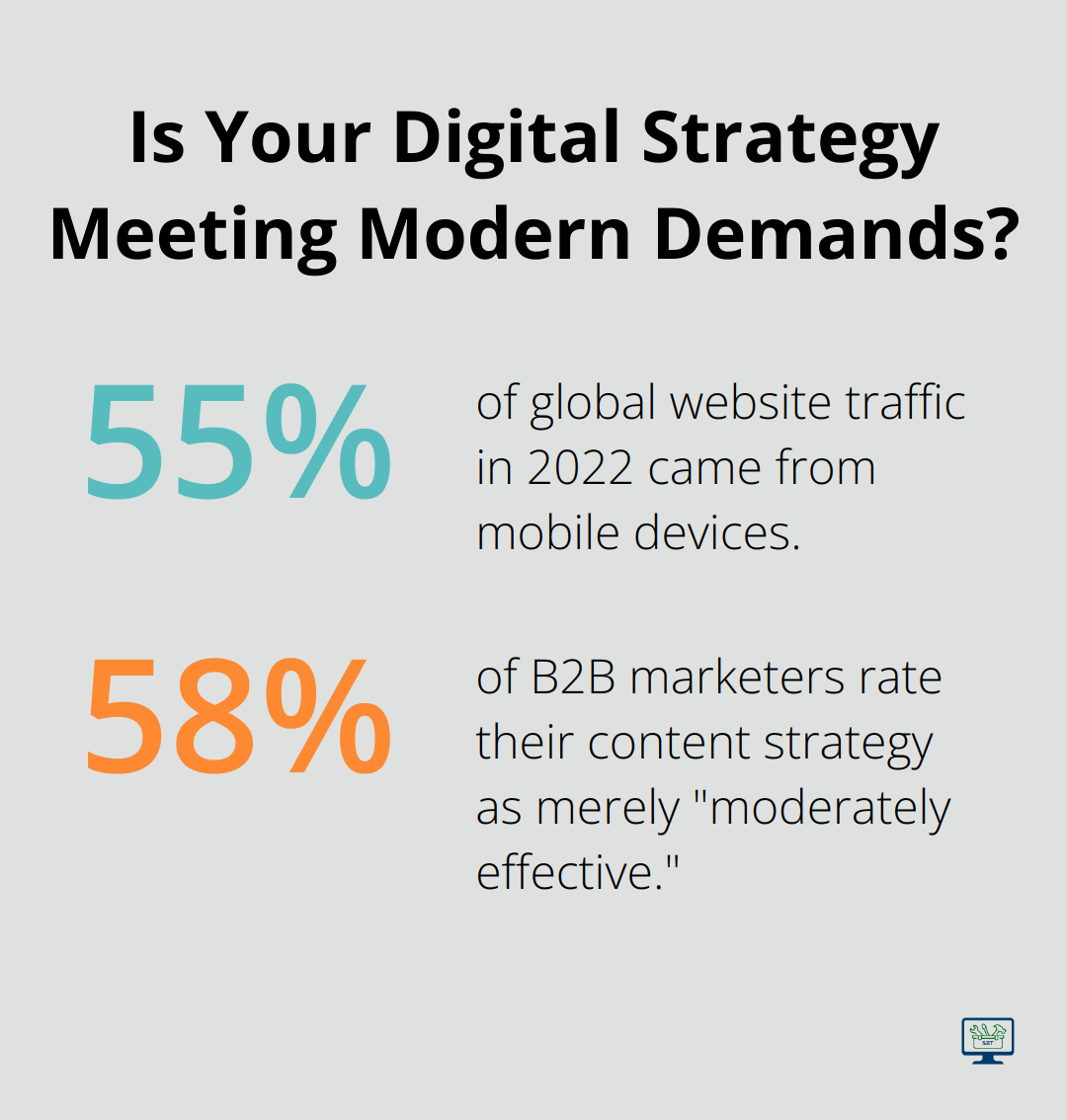
These key elements form the foundation of an effective business website. The next step involves turning this knowledge into action. Let’s explore how to set up your business website and bring these elements to life.
How to Set Up Your Business Website
Choose Your Domain and Hosting
Your domain name acts as your digital address. Select a memorable, relevant, and easy-to-spell name. For Australian businesses, a .com.au domain often adds credibility. After securing your domain, find a hosting provider to store your website files. Look for providers with reliable uptime, excellent customer support, and scalability options for future growth.
Select Your Website Platform
Two main options exist for building your site: website builders or content management systems (CMS). Website builders (e.g., Wix or Squarespace) offer user-friendly interfaces ideal for those with limited technical skills. However, they can restrict more complex site designs. CMS platforms like WordPress provide more flexibility and control but require a steeper learning curve. WordPress powers 3X larger market share than the usage of the other 9 popular website builders and blogging platforms combined, making it a popular choice for businesses of various sizes.
Design Your Site
Align your website’s design with your brand identity and target audience preferences. Start with a clear structure: homepage, about us, services/products, contact page, and potentially a blog. Use a consistent color scheme and font throughout. Poorly designed websites may frustrate users and result in a high “bounce rate”, or people visiting the entrance page without exploring other pages within the site.
Create Compelling Content
Write clear, concise, and valuable content for your visitors. Use headers to break up text and improve scannability. Include high-quality images and videos where relevant. HubSpot states that 72% of marketers consider content creation their most effective SEO tactic. Include clear calls-to-action (CTAs) throughout your site to guide visitors towards desired actions.
Optimize for Search Engines
Implement Search Engine Optimization (SEO) to improve your website’s ranking in search results. Research keywords relevant to your business and incorporate them naturally into your content. Ensure your site loads quickly – Google reports that 53% of mobile site visits end if pages take longer than 3 seconds to load. Use descriptive URLs, meta titles, and meta descriptions for each page.
Test and Launch
Before going live, test your website thoroughly across different devices and browsers. Check all links, forms, and functionalities. Once everything works as intended, launch your site. (Plan for regular updates and improvements based on user feedback and analytics data to keep your site fresh and effective.)
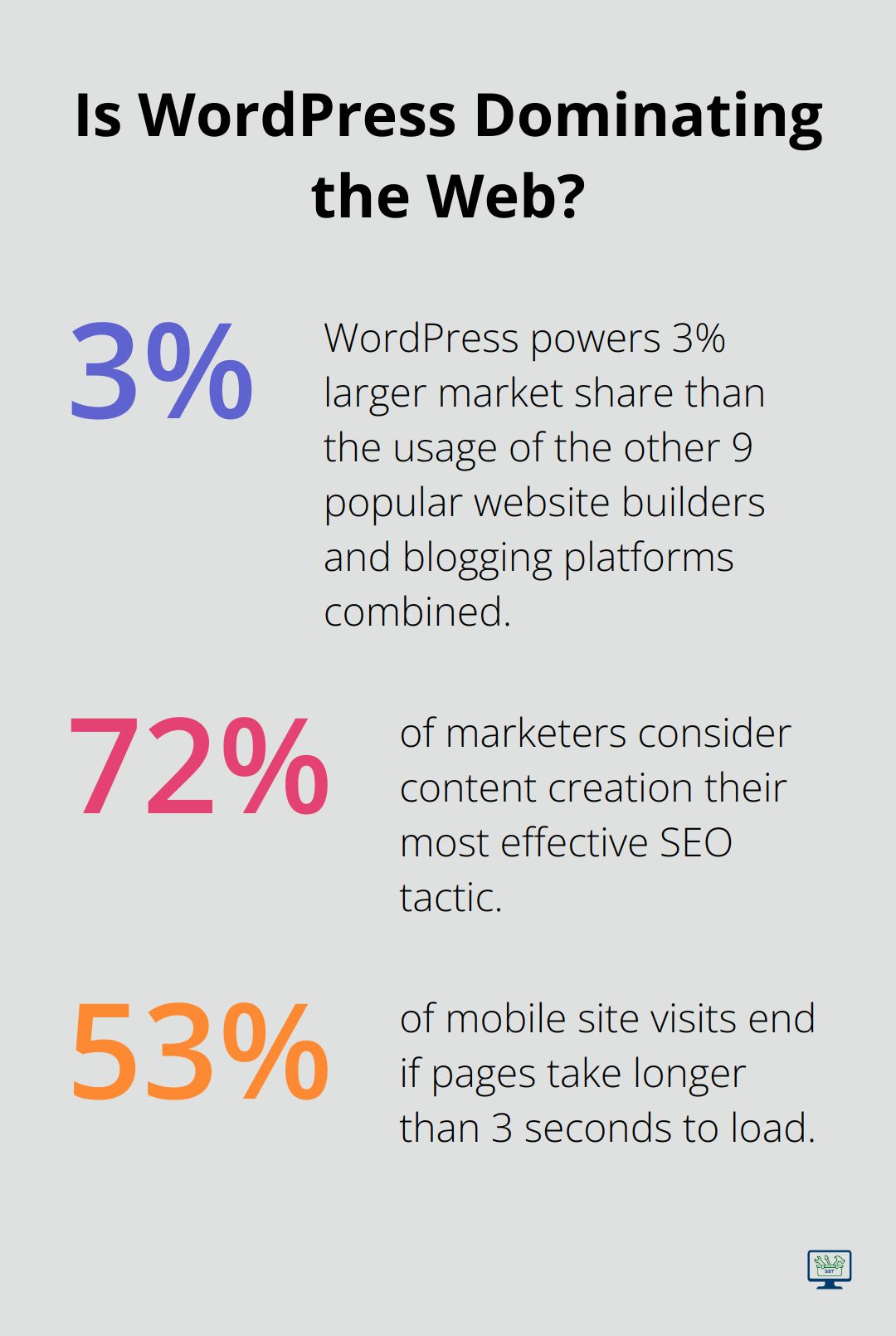
SEO Strategies
Tips for optimizing your website for search engines include conducting keyword research relevant to your business and incorporating those keywords naturally throughout your site. Ensure your website has a fast loading speed and is mobile-friendly, as these factors significantly influence search rankings. Additionally, creating quality backlinks and local listings can greatly improve visibility.
Content Creation Best Practices
An effective content strategy is key to engaging your audience and enhancing your website’s credibility. Focus on creating informative, valuable, and original content that addresses the needs and interests of your target audience. Utilize various formats such as blog posts, videos, and infographics to keep your content dynamic and appealing. Establishing a consistent posting schedule can also help maintain your audience’s interest over time.
Understanding your audience’s preferences and pain points is necessary for crafting content that resonates with them. By analyzing engagement metrics and user feedback, you can refine your content strategy to ensure it meets their needs. Additionally, utilizing storytelling techniques can make your content more relatable, while optimizing for SEO enhances its discoverability. Aim for a balance between quality and quantity to attract and retain visitors effectively.
Maintenance and Updates for Your Website
Now that you have your website up and running, it’s important to prioritize ongoing maintenance and updates to ensure its continued success. Regularly scheduled checks can help you keep your site running smoothly, optimize its performance, and make a lasting impression on your visitors. By staying on top of your website’s needs, you’ll enhance user experience and maintain your online presence effectively.
Regular Content Updates
On a regular basis, it’s vital to refresh your content to keep it relevant and engaging. This includes updating blog posts, adding new products or services, and sharing industry insights that resonate with your audience. By providing updated information, you improve your search engine rankings and foster trust and loyalty among your visitors.
Technical Maintenance
Maintenance of your website’s technical components is equally important to prevent downtime and security breaches. This involves regular checks of plugins, themes, and overall site functionality to ensure everything is operating as it should. Monitoring speed, fixing broken links, and backing up your data regularly will help maintain the reliability and integrity of your site.
With the fast-paced nature of technology and frequent updates, you need to stay informed about the latest trends and security patches. Regularly updating your website’s software, plugins, and themes will protect you from vulnerabilities. Additionally, monitor your website’s performance using analytics tools, which can also reveal areas for improvement. Investing time in these technical aspects will ensure that your site remains user-friendly, secure, and competitive in your industry.
Evaluating Your Website’s Performance
Not assessing your website’s performance can lead to missed opportunities for growth and improvement. You need to understand how your site is performing to make informed decisions about your business. By regularly evaluating key metrics, you can ensure that your website is effectively serving your audience and contributing to your goals.
Key Metrics to Monitor
Some important metrics to keep an eye on include your website’s traffic, conversion rates, bounce rates, and time spent on pages. Understanding these metrics will help you gauge user engagement and identify areas where improvements can be made to enhance overall performance.
Tools for Analysis
For effective website analysis, you can utilize various tools that provide insightful data about your site’s performance. These tools help you track key metrics, facilitating informed decisions that can optimize your online presence.
The most popular tools include Google Analytics, which offers in-depth traffic and engagement reports, and SEMrush, which provides insights into your website’s SEO health and competitor analysis. Other useful options are Hotjar, which visualizes user behavior with heatmaps, and Ahrefs, which tracks backlinks and keyword performance. Using these tools will empower you to identify strengths and weaknesses in your website, guiding your improvements for better performance.
Final Thoughts
A small business website is essential for growth and success in today’s digital landscape. It serves as a 24/7 digital storefront, expands reach beyond geographical boundaries, and showcases products or services to a global audience. A well-crafted website builds credibility, offers cost-effective marketing, and provides valuable insights into customer behavior.
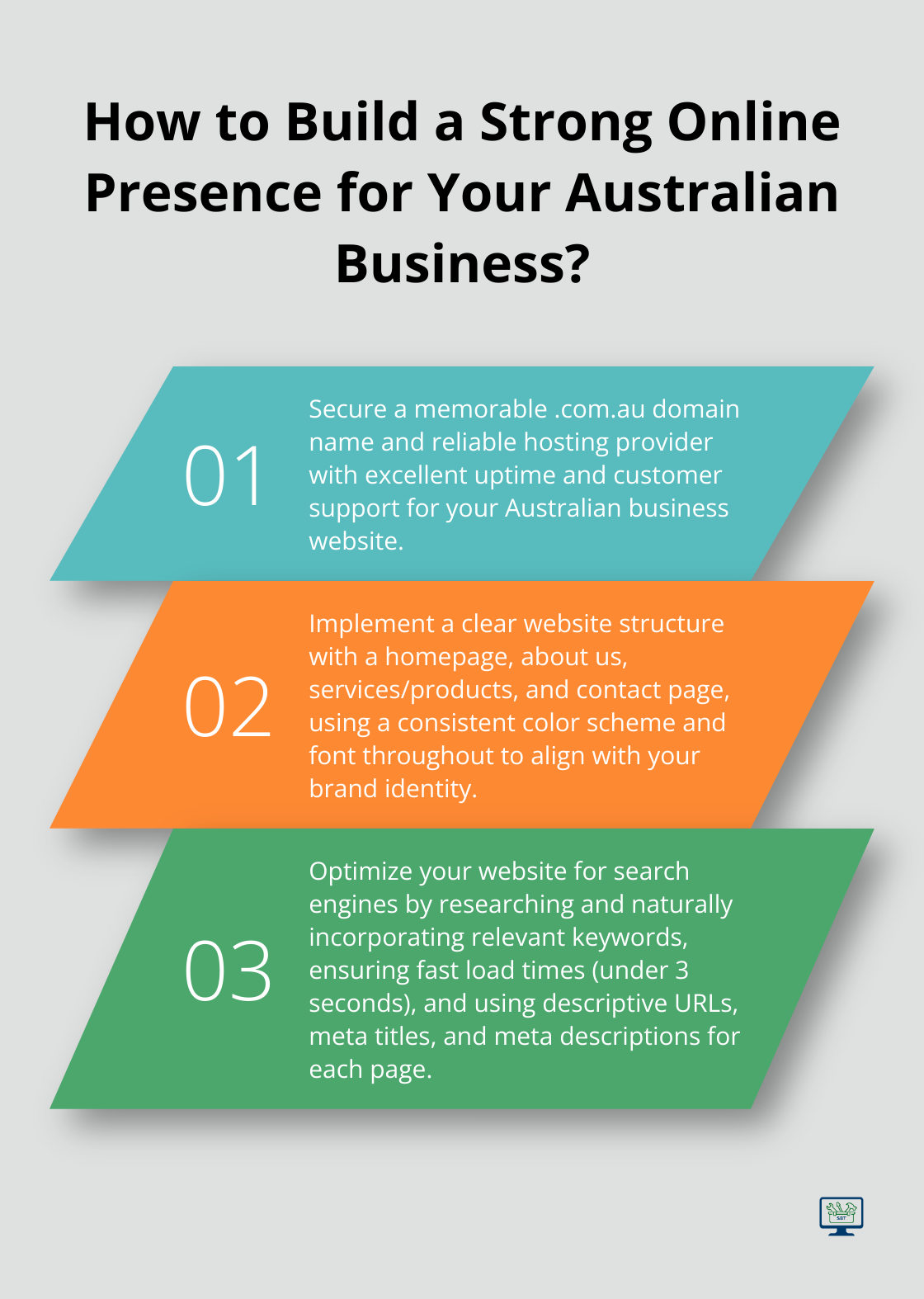
Creating an effective business website involves several key steps. Choose a memorable domain name and reliable hosting provider, then select a website platform that aligns with your technical skills and business needs. Design your site with user experience in mind, develop compelling content that resonates with your target audience, and optimize for search engines.
At SmallBizToolbox, we offer tools and resources to help Australian small businesses establish their online presence. Our platform provides support for AI-driven content creation and SEO optimization (among other features). Take the first step today in creating your small business website and let future customers discover you in the digital world.
How useful was this Resource?
Click on a star to rate it!
Average rating 0 / 5. Vote count: 0
No votes so far! Be the first to rate this post.
We are sorry that this post was not useful for you!
Let us improve this Resource!
Tell us how we can improve this Resource?

